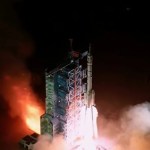Sentinel-6B data will continue decades of sea surface elevation recording, helping to improve coastal planning, protect critical infrastructure and improve weather forecasts.
Launch is scheduled no earlier than 12:21 pm EST on Monday, November 17th. Sentinel-6B is the latest in a series of spacecraft that NASA and its partners have used to measure sea levels since 1992. Their data has helped meteorologists improve hurricane forecasts, managers protect infrastructure and plan for coastal communities.
Once launched, Sentinel-6B will begin the process of cross-calibrating data with its predecessor. Sentinel-6 Michael Freilichto provide important information about Earth's oceans.
Sentinel-6B is the second of two satellites included in the Sentinel-6/Jason-CS (Continuity of Service) mission, a collaboration between NASA, ESA (European Space Agency), EUMETSAT (European Organization for the Exploitation of Meteorological Satellites) and the National Oceanic and Atmospheric Administration (NOAA). The European Commission provided financial support and the French space agency CNES (National Center for Space Research) provided technical expertise.
Here are six things to know about Sentinel-6B and the broader Copernicus Sentinel-6/Jason-CS mission:
1. Sentinel-6B will transmit data on approximately 90% of Earth's oceans, directly benefiting humanity..
Sentinel-6B will contribute to a multi-decade dataset of sea level measurements from space. This data is key to improving public safety, urban planning, and protecting commercial and defense interests.
This dataset, pioneered by NASA and its partners, allows users in government, industry and the research community to better understand how sea levels are changing over time. Combined with information from other NASA satellites, Copernicus Sentinel-6/Jason-CS data is vital for tracking how heat and energy move through Earth's seas and atmosphere, as well as monitoring ocean features such as currents and eddies. The measurements come from a radar altimeter that measures sea level across nearly all of Earth's oceans, providing information on large-scale currents that can help commercial and naval navigation, search and rescue, and tracking debris and pollutants from natural disasters at sea.
Photo: NASA/JPL-Caltech.
2. Data from the Copernicus Sentinel-6/Jason-CS mission helps NASA prepare for the next phase of space exploration..
The better we understand the Earth, the better NASA can accomplish its mission of exploring the universe. Data from the Copernicus Sentinel-6/Jason-CS mission is being used to refine the Goddard Earth Observing System's atmospheric forecasting models, which NASA's Safety Engineering Center uses to plan safer atmospheric reentry for astronauts returning from the Artemis missions.
In addition, changes in Earth's oceans observed from satellites could have measurable consequences beyond our planet. For example, although the Moon influences ocean tides on Earth, changes in those tides can also have a small effect on the Moon. Copernicus Sentinel-6/Jason-CS data could help improve understanding of this relationship, knowledge that could inform future lunar exploration missions.
3. The Copernicus Sentinel-6/Jason-CS mission helps the United States respond to challenges by putting actionable information in the hands of decision makers..
Data collected by the mission helps city planners and local and state governments make informed decisions to protect coastal infrastructure, real estate and energy assets. The mission's sea level data also improves meteorologists' weather forecasts, which are critical for commercial and recreational navigation. By improving weather forecasting models, data provided by Copernicus Sentinel-6/Jason-CS improves forecasts of hurricane development, including the likelihood of storm intensification, which can help support disaster preparedness and response.
4. Sentinel-6B Data Will Help National Security Efforts.
Sentinel-6B's ocean and atmospheric measurements will allow decision makers to better protect coastal military installations from events such as nuisance flooding, while aiding national defense efforts by providing critical information about weather and ocean conditions. The satellite will do this by feeding data about Earth's atmosphere and seas in near real time to weather and ocean forecast models. Because measurements are part of a long-term data set, they can also add historical context that puts new data into perspective.
5. The Copernicus Sentinel-6/Jason-CS mission's direct observations of sea level provide information critical to protecting coastlines where nearly half the world's population lives..
Sea level rise varies from one area to another, meaning some coastlines are more vulnerable than others to flooding, erosion and saltwater contamination of underground freshwater supplies, the latter of which threatens farmland and drinking water. Sea level measurements from Michael Freilich's Sentinel-6, and soon Sentinel-6B, form the basis of U.S. flood forecasts for coastal infrastructure, real estate, energy storage sites and other coastal assets. Knowing which regions are more vulnerable to these risks will allow U.S. industry and emergency managers to make more informed decisions about transportation and commercial infrastructure, land use planning, water management, and adaptation strategies.
6. International cooperation at the heart of the mission brings together capabilities, resources and expertise..
The multi-decade dataset that this mission supports is the result of many years of close work between NASA and several partners, including NASA, ESA, EUMETSAT, CNES and NOAA. By combining expertise and resources, this partnership provided cost-effective solutions that made accurate and actionable data available to both industry and government agencies.
More about Sentinel-6B
Copernicus Sentinel-6/Jason-CS was developed jointly by ESA, EUMETSAT, NASA and NOAA, with financial support from the European Commission and technical support from CNES. The mission also marks the first international participation in Copernicus, the European Union's Earth observation program.
The Jet Propulsion Laboratory, operated for NASA by the California Institute of Technology in Pasadena, provided three science instruments for each Sentinel-6 satellite: Advanced Microwave Radiometer, Global Navigation Satellite System – Radio OccultationAnd laser retroreflector grating. NASA also provides launch services, ground systems supporting NASA's science instruments, science data processors for two of these instruments, and support to the international ocean surface topography community.
For more information about Sentinel-6B, visit:
https://science.nasa.gov/mission/sentinel-6B
News Media Contacts
Elizabeth Vlok
NASA Headquarters, Washington
202-358-1600
[email protected]
Andrew Wang / Andrew Good
Jet Propulsion Laboratory, Pasadena, California.
626-379-6874 / 626-840-4291
[email protected] / [email protected]
2025-124








